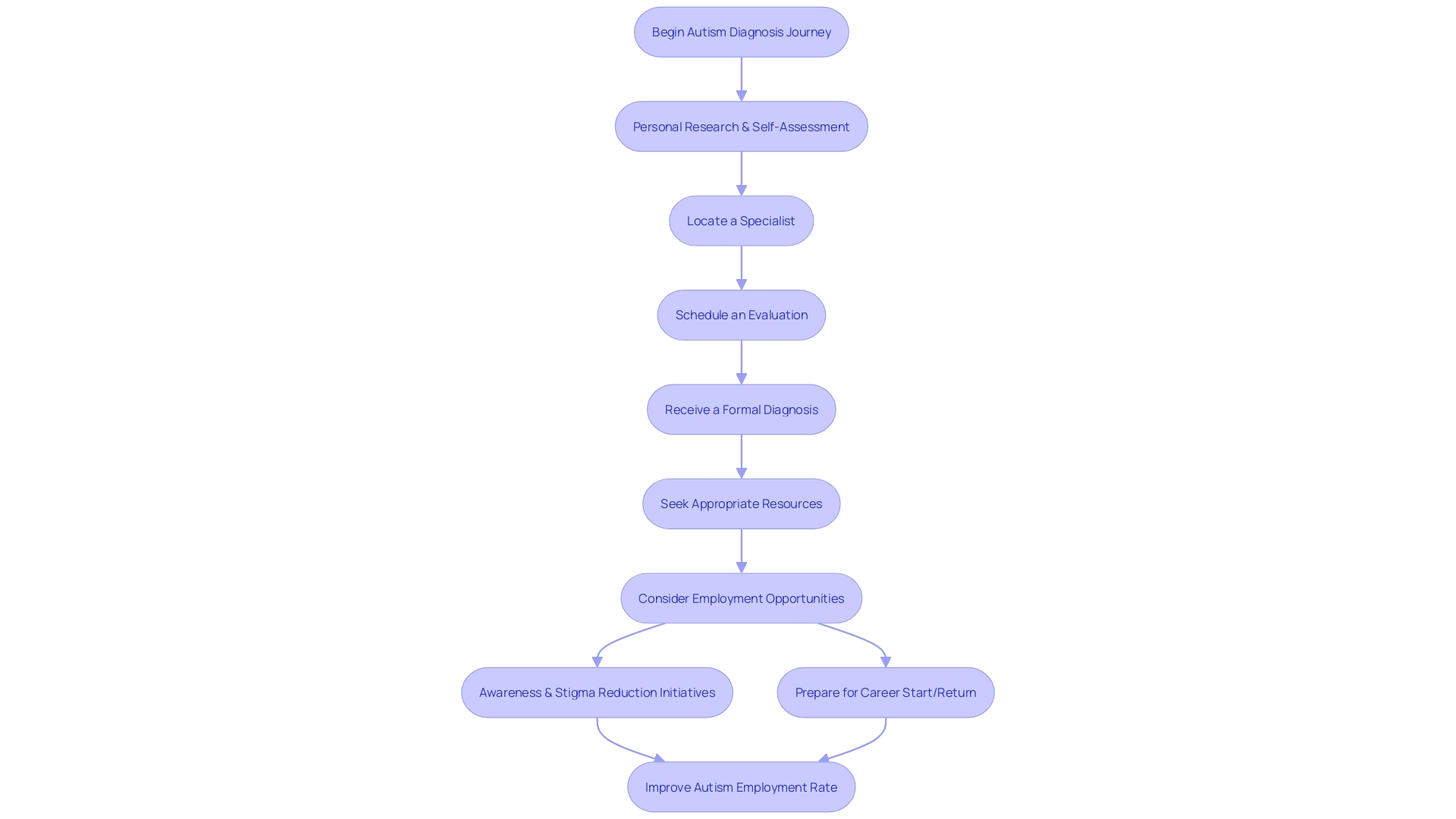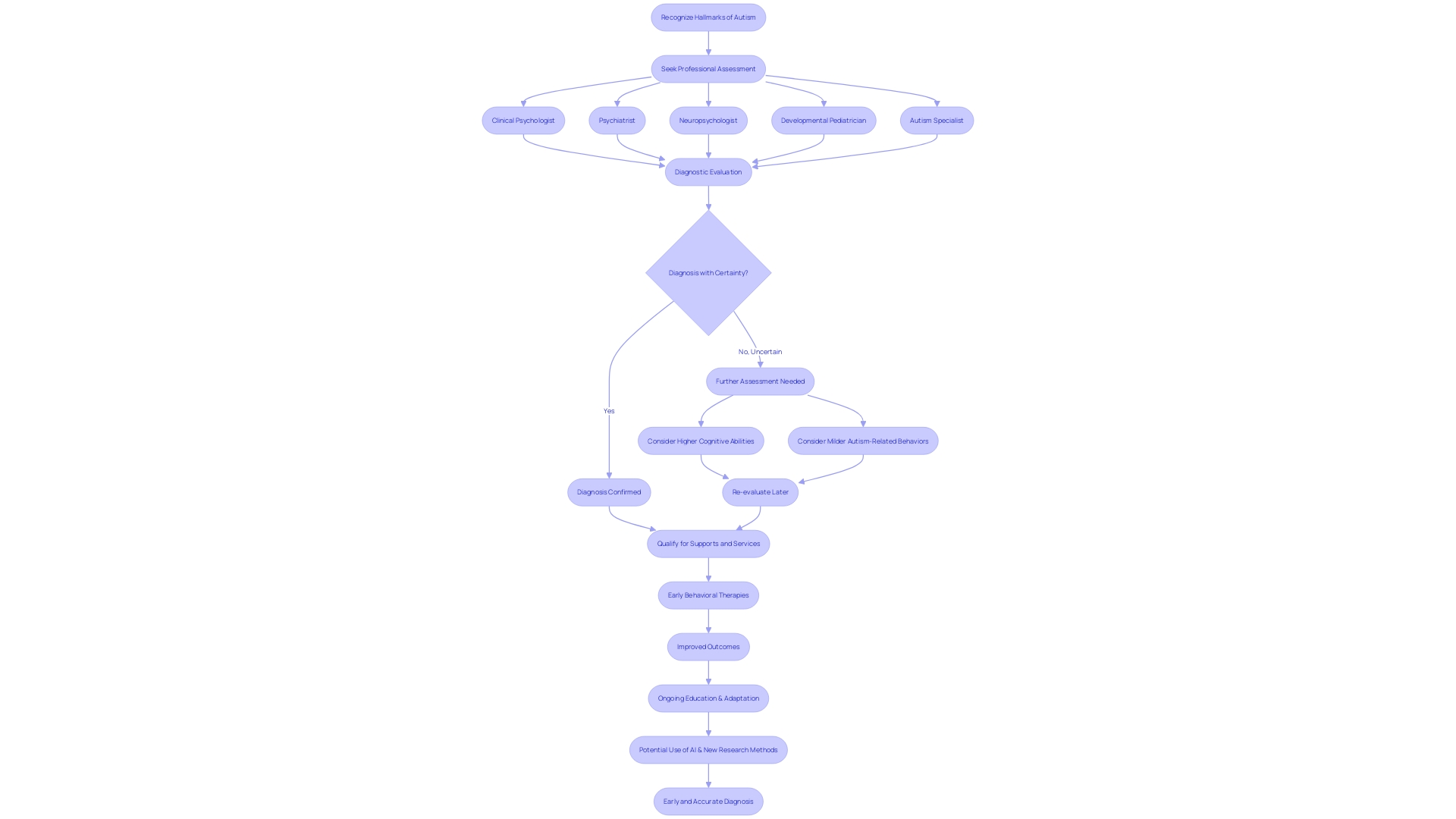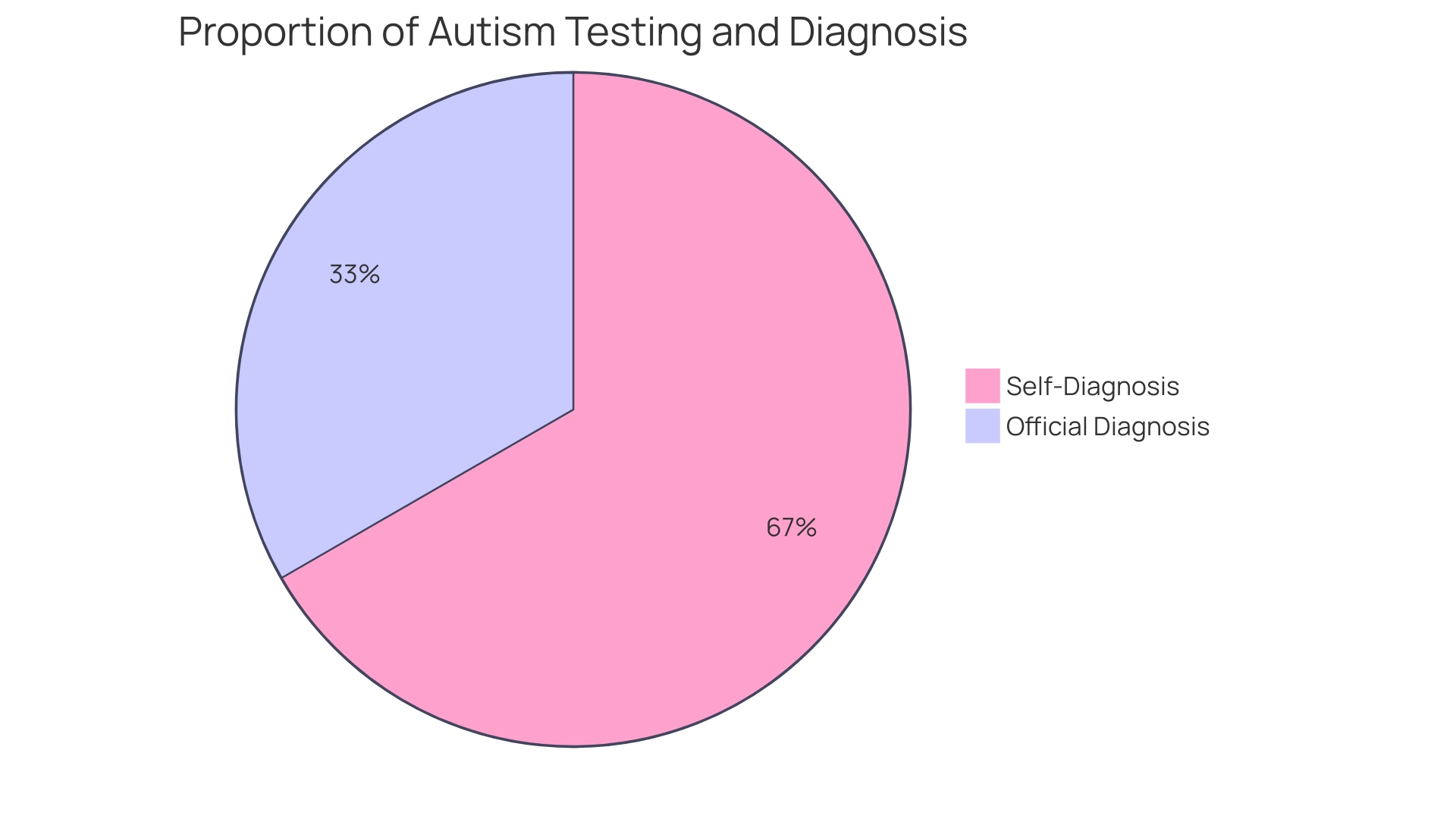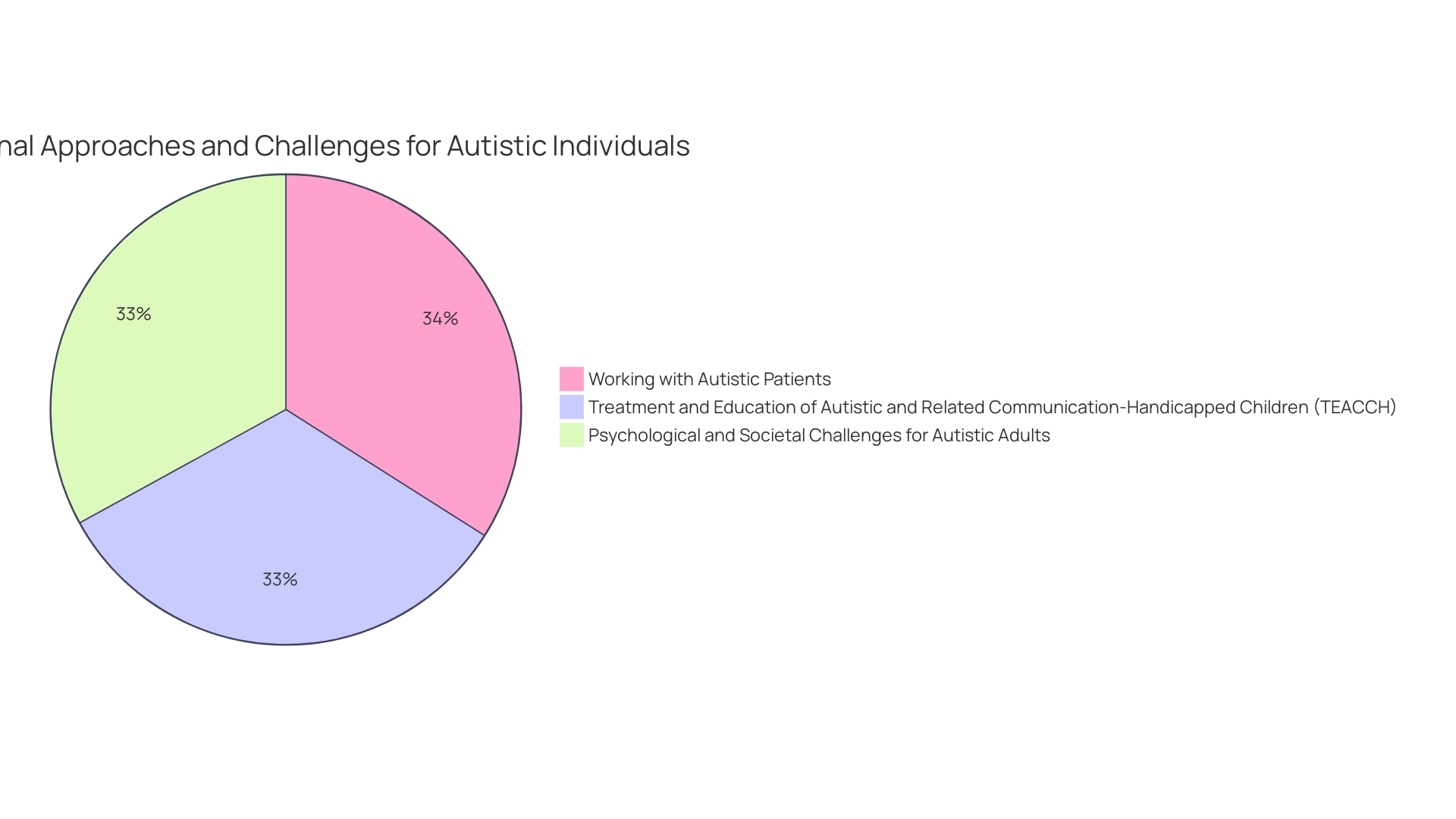Introduction
Embarking on the journey to an adult autism diagnosis can be transformative, offering newfound understanding and pathways to support. For adults who have navigated life with undiagnosed autism, a diagnosis brings clarity and explanation for their unique experiences. Moreover, an official diagnosis can unlock specialized support services, enhancing life skills and fostering acceptance in personal and communal spaces.
Heather Florio's story exemplifies the impact of self-realization, reshaping one's self-concept and encouraging others to seek their own diagnoses. While the diagnostic process can present challenges, the increasing awareness and advocacy around adult autism are leading to improved healthcare systems and initiatives. Whether through self-diagnosis or formal assessment, the recognition of one's neurodivergence is a step toward self-understanding and community belonging.
Why Seek an Adult Autism Diagnosis
Embarking on the journey to an adult autism diagnosis can be a transformative experience, offering newfound understanding and pathways to support. Self-acknowledgment is a powerful motivator; adults who have navigated life with undiagnosed autism often find clarity and explanation for their unique life experiences post-diagnosis. Moreover, an official diagnosis can be the key to unlocking a suite of specialized support services, enhancing life skills from education to employment and interpersonal relationships.
For many, the diagnosis is a badge of legitimacy, providing validation and facilitating acceptance in both personal and communal spaces. It's not uncommon for adults to pursue a diagnosis to confirm their self-identification as autistic, especially given the neurodivergent community's inclusive stance on self-diagnosis. Despite potential challenges in the medical testing process, which may yield inconclusive results, the desire for official recognition can be driven by a need for personal affirmation or to establish credibility among others.
This pursuit is underscored by narratives like that of Heather Florio, a CEO who was diagnosed at age 41, after a lifetime of feeling out of place. Her diagnosis marked a turning point, allowing her to embrace her differences and encouraging others to seek their own diagnoses. The impact of this self-realization can be profound, reshaping one’s self-concept and providing a lens through which to reevaluate past challenges and strengths.
It's important to acknowledge that the diagnostic process for autism is comprehensive and can present barriers. Adults seeking a diagnosis must navigate assessments that examine developmental history, cognitive and behavioral patterns, and self-reported experiences. The scarcity of professionals qualified to assess adults can add to the complexity.
Yet, the increasing awareness and advocacy around adult autism are leading to more informed healthcare systems and initiatives aimed at improving the lives of autistic adults.
While the decision to seek a diagnosis is deeply personal and contingent on individual circumstances, the overarching sentiment within the community is one of solidarity and respect for each person's journey. Whether through self-diagnosis or formal assessment, the recognition of one's neurodivergence is a step toward self-understanding and community belonging.
Challenges in Diagnosing Autism in Adults
Gaining a diagnosis of autism in adulthood is often a complex journey, marked by several obstacles. Adults on the autism spectrum may have spent years developing coping mechanisms to blend into neurotypical society, a phenomenon known as masking or camouflaging. This adaptive strategy can obscure the tell-tale signs of autism, posing a significant challenge for professionals tasked with making an accurate assessment.
Awareness and understanding of autism in adults lag behind that for children, potentially leading to misdiagnosis or the misattribution of symptoms to other conditions. Adults who do seek a diagnosis may find a scarcity of healthcare providers with the requisite expertise in adult autism, which translates to protracted waiting periods and a struggle to find professionals who are adept at evaluating nuanced adult presentations of autism.
The autistic and neurodivergent community acknowledge that not everyone may seek or require a formal diagnosis, especially when financial and emotional costs are factored in. However, for some, a formal diagnosis is a tool for self-affirmation and helps in communicating their needs to those around them. Statistics show that 1 in 45 adults in the U.S. are diagnosed with ASD, indicating that there may be a considerable number of undiagnosed adults adapting to life's challenges without the understanding or support that a diagnosis might afford.
The process of adult diagnosis involves a comprehensive evaluation, including a developmental history review and various assessments. Yet, barriers such as inadequate access to suitable assessors remain. As revealed by recent news, challenges in autism diagnosis extend to children, especially within minority, low-income, and rural communities.
Efforts to introduce objective biomarkers and innovative diagnostic tools like AI-assisted eye-tracking technology aim to bridge these disparities and provide earlier, life-altering interventions.
In light of these challenges, it's crucial to understand the hallmarks of autism in adults—difficulties with social communication and repetitive behaviors—and to recognize the strengths that autistic individuals bring to the table. General healthcare practitioners, with minimal additional training, can learn to work effectively with autistic adults, thereby expanding the network of support and reducing the need for specialist referrals. This inclusive approach is not only beneficial for those on the spectrum but enriches the practice of healthcare providers by fostering a diverse patient community.
Steps to Get Evaluated for Autism as an Adult
Embarking on an adult autism diagnosis journey is a multi-faceted process that encompasses introspection, professional evaluation, and subsequent support. It commences with personal research and self-assessments, where individuals explore the signs of autism in adults and reflect on their own experiences. Recognizing signs like difficulty with social communication and repetitive behaviors is critical, as these are core characteristics of autism, regardless of age.
Once self-assessment indicates possible autistic traits, the next step is to locate a specialist experienced in adult autism diagnosis. This could be a psychologist, psychiatrist, or neuropsychologist. Scheduling an evaluation is pivotal, where you'll provide a comprehensive personal history and undergo cognitive and behavioral assessments, possibly including feedback from those close to you.
The evaluation is a thorough process that may reveal the need for support strategies and resources. Professionals agree that while self-diagnosis is accepted within the neurodivergent community, a formal diagnosis can open doors to tailored assistance and interventions. This is vital considering the societal and psychological challenges many autistic adults face, such as anxiety and depression, for which they often seek the same therapeutic needs as others.
After a diagnosis, individuals are advised to seek appropriate resources. The importance of early and accurate diagnosis is echoed by advocacy groups and research organizations, highlighting the potential for improved outcomes with timely intervention. Notably, the CDC estimates autism occurs in as many as 1 in 36 individuals, underscoring the necessity for accessible diagnostic tools and support networks.
The journey to an autism diagnosis as an adult is deeply personal and should be navigated with care and consideration for individual needs and circumstances. While the path is not without its hurdles, understanding one's own needs and learning to advocate for appropriate support can lead to a more fulfilling life.

Who to Consult for an Adult Autism Diagnosis
Navigating the journey to an adult autism diagnosis involves understanding the various professionals equipped to assess and diagnose autism spectrum disorder (ASD) in adults. Clinical psychologists, with their focus on autism assessments, offer comprehensive evaluations, while psychiatrists bring their medical expertise to diagnose and manage medication. Neuropsychologists delve into cognitive and behavioral evaluations, important aspects of the diagnostic process.
Developmental pediatricians, although more commonly associated with children, have valuable insights into developmental disorders. Additionally, autism specialists, with their dedicated training, provide a nuanced understanding of autism in adults.
A diagnosis can be transformative, as seen in Heather Florio's case, who at the age of 41, gained a new understanding and acceptance of herself after being diagnosed with autism. This echoes the experiences of many adults who, despite the prevalence of autism (1 in 45 adults in the U.S.), may have lived without a diagnosis or received a misdiagnosis. Recognizing the hallmarks of autism—challenges in social communication and restrictive, repetitive behaviors—is the first step towards addressing undiagnosed ASD.
The journey to a diagnosis is deeply personal and varies for each individual. Some may find solace in self-identification without pursuing a clinical diagnosis, a view supported by the broader autistic and neurodivergent community. This approach acknowledges the complexities and potential inconclusiveness of medical testing for autism.
For others, an official diagnosis serves to validate their experiences and facilitate understanding among peers and family members.
Professionals who work with autistic adults must understand their specific needs and the psychological and societal challenges they face. Skills in establishing trust and recognizing the common strengths of autistic individuals are crucial. While some therapeutic needs may overlap with the general population, autistic adults often report difficulties in accessing appropriate care, highlighting the importance of inclusive practices among practitioners.
In light of recent technological advances, AI and new research methods are emerging as potential tools for early autism diagnosis, pointing to a future where diagnostics could become more accessible and tailored to individual needs. This evolution underscores the importance of ongoing education and adaptation within the medical community to better serve the growing number of adults seeking an autism diagnosis.

Using Self-Assessment Tools and Checklists
- Autism Quotient (AQ): A tool that quantifies autistic traits focusing on social skills, communication patterns, and behavioral tendencies.
- Ritvo Autism Asperger Diagnostic Scale-Revised (RAADS-R): This questionnaire aids in evaluating the presence and intensity of autistic traits.
- Social Responsiveness Scale (SRS): Used by individuals or their close contacts, the SRS evaluates social abilities, communication, and behaviors indicative of autism.
- Childhood Autism Spectrum Test (CAST): Helps to identify signs of autism that may have been overlooked during childhood.
These assessments provide insight into personal experiences and facilitate discussions with healthcare professionals. With 1 in 45 adults in the U.S. diagnosed with ASD, many may live unaware of their autism. It's crucial to recognize adult autism signs, such as difficulties in social communication and repetitive behaviors.
While self-diagnosis is accepted within the autistic community due to the challenges of obtaining a conclusive medical diagnosis, some opt for an official diagnosis for personal reasons or to gain understanding from others. Despite the prevalence of autism, adults often encounter barriers when seeking support, as many practitioners are not adequately equipped to address their needs. New technology is emerging, such as eye-tracking devices that predict autism diagnoses with high accuracy, offering hope for better recognition and support for autistic adults.

Gathering Information About Childhood Development
Exploring one's developmental history is a critical aspect when seeking an adult autism diagnosis. It's important to note that the necessity of a formal diagnosis is a personal choice, with the autistic and neurodivergent community readily accepting self-identification due to the complexities and often inconclusive results of medical testing. Nevertheless, if one opts for a professional evaluation, providing a detailed developmental history can be instrumental.
To piece together this history, consider engaging family members in dialogue about your childhood behaviors and milestones, which could shed light on early signs of autism. Old medical records, school reports, and any documents that chart your early years can be a treasure trove of insights. Additionally, reaching out to childhood educators could offer a different perspective on your social and communication skills during those formative years.
This multifaceted approach to gathering information empowers you to present a comprehensive narrative to healthcare providers, facilitating an accurate assessment. Recent studies, including one by Boston University, have shown a significant rise in adult autism diagnosis, emphasizing the evolving awareness and recognition of the condition in adults. With 1 in 45 adults in the U.S. now diagnosed with autism spectrum disorder (ASD), understanding the common signs and symptoms of autism can be pivotal for those who suspect they may be autistic.
Reflecting on one's life experiences and aligning them with adult manifestations of autism, such as challenges in social communication and repetitive behaviors, can lead to greater self-awareness and the pursuit of appropriate support.
Common Symptoms and Behaviors to Look For
Autism spectrum disorder (ASD) presents through a variety of signs and behaviors, and understanding these can be the first step toward recognizing it in adults. Common indicators include social challenges, such as difficulty interpreting social cues or maintaining eye contact, which may lead to trouble in forming and sustaining relationships. Communication can also be a hurdle, with some adults experiencing atypical language patterns or non-verbal communication issues.
Repetitive behaviors are another signpost, including strict adherence to routines, intense focus on specific subjects, or repetitive movements. Sensory sensitivities may manifest as an acute aversion or heightened response to particular textures, sounds, or lights. Additionally, executive functioning can be affected, seen in challenges with organization, planning, and flexibility in thinking.
It's important to acknowledge that these traits can manifest differently across individuals and vary in intensity. ASD is a spectrum condition, affecting people uniquely. The Centers for Disease Control and Prevention (CDC) estimates ASD occurs in as many as 1 in 36 individuals.
Yet, awareness and understanding of autism in adults are still evolving. Many adults with autism may have spent their lives undiagnosed or misdiagnosed. Heather Florio's story is a compelling case; diagnosed at 41, she encourages others who feel they might be on the spectrum to pursue a diagnosis, which for her led to self-acceptance and understanding.
Self-diagnosis is widely accepted within the autistic and neurodivergent community due to the challenges and limitations of the medical testing model for autism. However, some choose to seek a formal diagnosis for personal reasons, such as reinforcing their self-identification or helping others understand their condition. Awareness efforts and public health outreach have led to improved screening, but with the statistic of 1 in 45 U.S. adults diagnosed with ASD, it's clear that more adults may be living with undiagnosed autism.
Recognizing the signs can empower individuals to seek the appropriate resources and support that can significantly impact their quality of life.
Therapy and Support Options After Diagnosis
Navigating the journey after an adult autism diagnosis presents a unique set of challenges and opportunities. Individuals may find solace and progress in a variety of therapeutic and support avenues tailored to their needs.
-
Applied Behavior Analysis (ABA) therapy: ABA is a well-structured program that aims to enhance social, communicative, and behavioral competencies. Its adaptability makes it a valuable tool for individuals across the autism spectrum, regardless of age.
-
Speech and language therapy: Enhancing communication skills is at the core of speech and language therapy. This form of therapy addresses a range of communicative aspects, from speech articulation to understanding language and mastering the subtleties of social interaction.
-
Occupational therapy: For those seeking to improve their daily living skills, occupational therapy focuses on fine motor skills, self-care routines, and sensory integration, enabling a more independent lifestyle.
-
Support groups: The power of community cannot be understated. Support groups offer a welcoming environment to connect with peers, exchange insights, and gain emotional support from those with shared experiences.
-
Counseling and mental health support: It's not uncommon for individuals with autism to encounter mental health concerns. Counseling and therapy can provide a supportive space to explore these issues with professionals attuned to the nuances of autism.
Despite the availability of these supports, the journey to an autism diagnosis can be complex. A diagnosis may not be essential for everyone, as self-identification is widely accepted within the autistic and neurodivergent communities. However, for those seeking official recognition, perhaps to affirm their experiences or to help others understand, the pursuit of a diagnosis can be an affirming step.
Autistic adults face a stark reality upon transitioning out of the school system, often losing access to vital services. This lack of support is why initiatives like the Adult Autism Health Resources project are critical. They strive to educate healthcare professionals and advocate for the needs of the adult autistic community, ensuring access to quality medical care akin to that available to neurotypical individuals.
It's vital to remember that for many autistic adults, therapeutic needs may not differ significantly from the general population, particularly regarding common conditions like anxiety or depression. Yet, these individuals often encounter barriers when seeking care. Through increased awareness and targeted education, healthcare providers can better serve this community, fostering trust and ensuring that autistic adults receive the comprehensive care they deserve.
Navigating Insurance and Governmental Protections
Understanding your insurance policy is the first step in accessing services after an adult autism diagnosis. It's essential to know what therapies and supports your insurance covers, as some may require extra documentation or pre-authorization. For those considering or uncertain about the need for a formal diagnosis, the autistic community widely accepts self-diagnosis due to the complex nature of medical testing for autism, which often results in inconclusive outcomes.
However, an official diagnosis can be beneficial for those seeking to validate their experiences, particularly in contexts where formal recognition is crucial.
In parallel, it is important to be informed about governmental protections and benefits. For instance, the U.S. Department of Health and Human Services' recent report highlights the expansion of Medicaid services through the HCBS Rule, mandating previously optional services. Additionally, programs like Kevin and Avonte's Law have allocated $10.3 million since 2018 to address wandering in individuals with autism, demonstrating the government's role in providing critical support.
Seeking professional guidance can streamline navigating these systems, ensuring you advocate effectively for your rights. Maintaining thorough records of all evaluations and treatments is also crucial in this advocacy, as it provides tangible evidence of your needs and the services you're entitled to.
With nearly one in five people covered by Medicaid and the rise of initiatives like the Adult Autism Health Resources project, the focus on quality medical care for autistic adults is increasing. It's a call to recognize the needs of this population, ensuring access to the same level of care as neurotypical individuals. Moreover, public advocacy, such as urging the inclusion of ABA therapy in essential health benefits, showcases the ongoing efforts to ensure comprehensive coverage for autism services.
In summary, navigate insurance and governmental avenues with confidence by familiarizing yourself with your rights, staying informed about available programs, consulting experienced professionals, and keeping detailed documentation. These steps can empower you to secure the support and services you deserve.
Finding Community Resources and Support Groups
Navigating life after an adult autism diagnosis can be a transformative experience, especially when you find the right community resources and support groups. These networks serve as a beacon, guiding individuals through shared experiences and providing connections with those who truly understand the journey.
To tap into these invaluable supports, start by exploring online directories that catalog autism-related resources, including therapy services, support circles, and educational opportunities. Don't overlook the wealth of knowledge within local autism organizations and advocacy groups; they are often the custodians of community-specific resource lists and can point you in the direction of nearby support assemblies.
The digital age brings the power of connection right to your fingertips through social media platforms. By joining dedicated autism communities online, you open up a world where exchanging stories, posing questions, and uncovering local resources is just a click away. Moreover, engaging with parents of autistic individuals can yield a treasure trove of personal insights, advice, and recommendations for support channels in your area.
It's important to recognize the significant number of autistic adults that form part of our population, a fact highlighted by initiatives like the Adult Autism Health Resources at Massachusetts General Hospital. Such programs, spearheaded by experts like Christopher McDougle, MD, from Harvard Medical School, aim to bridge the gap in care autistic adults face post high school, rallying for continued access to quality healthcare.
The reality is, research on autistic adults, especially in their middle and older years, is scarce, as noted by Gregory Wallace, PhD, from The George Washington University. However, with the estimated prevalence rate of 1 in 45 adults in the U.S. diagnosed with autism spectrum disorder, the need for community support and access to proper medical care is more critical than ever. These figures underscore the importance of constructing a robust support network that not only acknowledges but actively supports the diverse needs of autistic adults.

Conclusion
In conclusion, the journey to an adult autism diagnosis is transformative and empowering. The increasing awareness and advocacy around adult autism are leading to improved healthcare systems and initiatives. Gaining a diagnosis of autism in adulthood can be complex, but efforts are being made to bridge the gaps in understanding and provide earlier interventions.
Recognizing the signs of autism in adults and seeking appropriate resources are crucial steps in the journey. Understanding the various professionals equipped to assess and diagnose autism in adults is important for receiving comprehensive care. Self-assessment tools and emerging technologies offer new avenues for early diagnosis and support.
Exploring one's developmental history and gathering information from various sources can empower individuals to present a comprehensive narrative to healthcare providers. Recognizing the signs and aligning them with adult manifestations can lead to greater self-awareness and the pursuit of appropriate support.
After a diagnosis, exploring tailored therapeutic and support options can enhance skills and well-being. Efforts are being made to ensure comprehensive coverage for autism services and provide quality care for autistic adults. Finding community resources and support groups is crucial for navigating life after an adult autism diagnosis.
In conclusion, the journey to an adult autism diagnosis is transformative and empowering. By recognizing the signs, seeking appropriate resources, and building a support network, individuals can enhance their self-understanding and well-being. Increased awareness and advocacy are driving improvements in healthcare systems and initiatives for autistic adults.
Together, we can create a more inclusive and supportive society for all.




